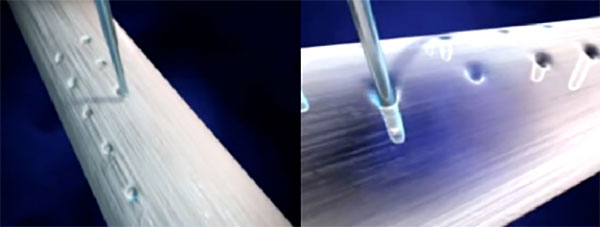Topaz Procedure
Topaz Procedure: Minimally Invasive Radiofrequency Treatment for Tendons and Fascia
The Topaz Procedure (or Topaz MicroDebrider) is a minimally invasive, state-of-the-art procedure used to treat chronic tendon and ligament conditions such as chronic Achilles tendonitis and chronic plantar fasciitis. Topaz is typically intended for patients who have not responded to more traditional conservative treatments, such as supportive insoles, oral anti-inflammatory, oral steroids, physical therapy, stretching, or massage. I have utilized this particular technology successfully for over 10 years in my practice and since it’s introduction have reduced the need for open surgical repair for issues such as plantar fasciitis and mild to moderate Achilles tendinosis by almost 90%.
How Does the Topaz Procedure Work?
The entire process takes only 5 minutes and is performed under light/twilight sedation using an intravenous sedation anesthetic (you are asleep but breathing on your own). The Topaz wand, which looks like a specialized sewing needle, is placed through a small poke-holes through the skin into the damaged area of fascia or tendon and radiofrequency is utilized for a split-second to create a small hole in the ligament/tendon. The Topaz wand uses cobalation technologies, which create the radiofrequency waves that gently cause microscopic “trauma” to the scar tissue that body wasn’t able to heal on its own. The procedure brings blood flow back to the affected area and reinitiates the healing process by converting a chronic form of inflammation into more of an acute and productive healing process. The strategically placed Topaz wand greatly minimizes any damage to surrounding healthy tissue.

The wand is used to create a grid like pattern of fenestration sites spread about a quarter-inch from each other in the affected area. Once this is accomplished, the area is then typically “seeded” with regenerative properties by injection of amniotic/placental materials or adult derived stem cell spin down products (harvested from the patient during the procedure) such as platelet rich plasma or bone marrow aspirate. Because the method is minimally invasive, recovery time from the Topaz procedure can be measured in weeks instead of months. After a week in a walking boot, most patients can begin wearing athletics shoes with orthotics. Also, there is no incision made and the dressings are removed the day after the procedure.
What is the Success Rate?
In my experience over the past 10 years, the topaz treatment mixed with a regenerative medicine component has been up to 90% successful in the avoidance of more traditional open surgical procedures/repairs. It’s important to note that the pain relief is not instantaneous and it may actually get worse before it gets better. However, once your recovery is complete, the pain is relieved, and the tendon/ligament are back to normal function. After a successful treatment, it should be emphasized that continued support to the area with proper shoes and/or insole and daily stretching is what it takes to avoid a recurrence of the condition.
Is Topaz Covered by Insurance?
Most insurance plans will cover the Topaz microdebridment procedure. We have had it covered in our practice and are happy to help you should you require this procedure. On the other hand, the use of injectable amniotic/placental tissue is still not typically covered by insurance. Since AOA has extensive experience/utilization of these tissues, we have been able to secure very affordable options for our patients so that they will continue to have access to the latest and greatest that regenerative medicine technologies have to offer.
